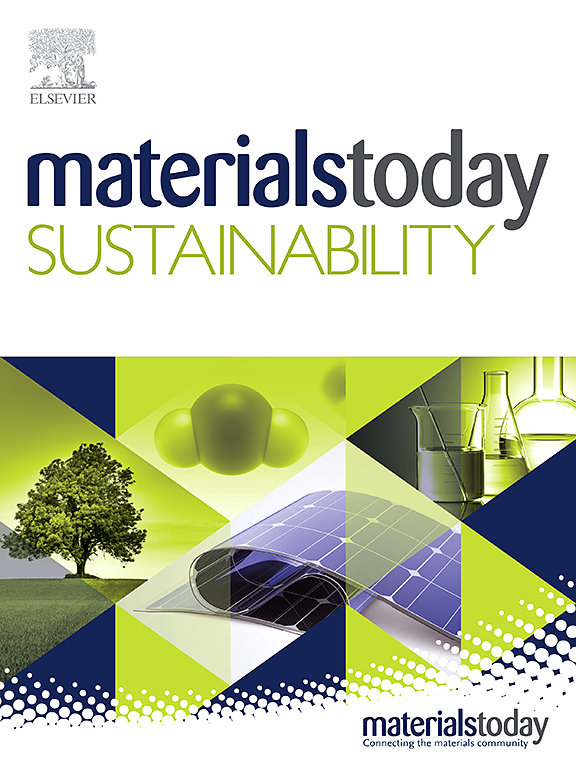Phytofabrication of silver nanoparticles using Ehretia rigida leaf aqueous extract, their characterization, antioxidant and antimicrobial activities
IF 7.1
3区 材料科学
Q1 GREEN & SUSTAINABLE SCIENCE & TECHNOLOGY
引用次数: 0
Abstract
The green synthesis of nanoparticles (NPs) offers a sustainable, rapid, and cost-effective alternative to traditional chemical and physical methods, with diverse applications across various fields. This study reports the synthesis of silver nanoparticles (AgNPs) using Ehretia rigida (Er) leaf aqueous extract and evaluates their biological activities. The formation of the NPs was confirmed by the change in colour from clear to dark brown. The synthesis parameters, such as pH, temperature, Er extract and silver nitrate (AgNO3) concentrations, reaction ratio, and incubation time, were optimized for high yields, controlled size, and stability of the NPs. The optimized Er-AgNPs were characterized using ultraviolet–visible (UV–vis) spectroscopy, dynamic light scattering (DLS), Fourier transform infrared (FTIR) spectroscopy, and high-resolution transmission electron microscopy (HR–TEM). The Er-AgNPs sample presented a characteristic absorbance peak at 408 nm, a hydrodynamic size of 74.02 ± 0.19 nm, a polydispersity index (PDI) of 0.39 ± 0.05, and a zeta potential of −25.4 ± 6.26 mV. FTIR analysis revealed the nature of the biomolecules responsible for the reduction and stabilization of the NPs. HR–TEM revealed that the Er-AgNPs were spherical, with core sizes ranging from 6 to 18 nm. The Er leaf aqueous extract and Er-AgNPs possessed antioxidant activities, with the Er leaf extract having higher activity than Er-AgNPs. The Er leaf extract did not exhibit any antimicrobial activity, whereas the Er-AgNPs demonstrated broad-spectrum antimicrobial activities against all the tested pathogens. This study provides a sustainable, easy and cost-effective method to produce AgNPs for biomedical applications.
刚硬体叶片水提物制备纳米银及其表征、抗氧化和抗菌活性
纳米粒子的绿色合成为传统的化学和物理方法提供了一种可持续、快速、经济的替代方法,在各个领域都有不同的应用。本文报道了以刚体Ehretia rigida (Er)叶片水提物为原料合成银纳米粒子(AgNPs)并对其生物活性进行了评价。NPs的形成可以通过颜色从透明变为深棕色的变化来证实。优化了合成条件,如pH、温度、Er萃取物和硝酸银(AgNO3)浓度、反应比例和孵育时间等,以保证NPs的高产率、粒径可控和稳定性。利用紫外-可见光谱(UV-vis)、动态光散射(DLS)、傅里叶变换红外光谱(FTIR)和高分辨率透射电子显微镜(HR-TEM)对优化后的Er-AgNPs进行了表征。Er-AgNPs样品的特征吸光度峰为408 nm,水动力尺寸为74.02±0.19 nm,多分散性指数(PDI)为0.39±0.05,zeta电位为- 25.4±6.26 mV。FTIR分析揭示了负责还原和稳定NPs的生物分子的性质。HR-TEM显示,Er-AgNPs为球形,核心尺寸在6 ~ 18 nm之间。Er- agnps和Er- agnps均具有抗氧化活性,且Er- agnps的抗氧化活性高于Er- agnps。Er叶提取物没有表现出任何抗菌活性,而Er- agnps对所有测试的病原体都表现出广谱的抗菌活性。本研究提供了一种可持续、简单、经济的方法来生产生物医学应用的AgNPs。
本文章由计算机程序翻译,如有差异,请以英文原文为准。
求助全文
约1分钟内获得全文
求助全文
来源期刊

Materials Today Sustainability
Multiple-
CiteScore
5.80
自引率
6.40%
发文量
174
审稿时长
32 days
期刊介绍:
Materials Today Sustainability is a multi-disciplinary journal covering all aspects of sustainability through materials science.
With a rapidly increasing population with growing demands, materials science has emerged as a critical discipline toward protecting of the environment and ensuring the long term survival of future generations.
 求助内容:
求助内容: 应助结果提醒方式:
应助结果提醒方式:


